
Lithops is a genus of succulent plants in the ice plant family, Aizoaceae. Members of the genus are native to southern Africa. The name is derived from the Ancient Greek words λίθος 'stone' and ὄψ 'face', referring to the stone-like appearance of the plants. They avoid being eaten by blending in with surrounding rocks and are often known as pebble plants or living stones. Lithops is both the genus name and the common name. The formation of the name from the Ancient Greek -ops means that even a single plant is called a Lithops.

Lithops francisci, commonly known as one of the living stones or pebble plants, is in the family Aizoaceae. It is endemic to the arid desert environments of Namibia. It is a succulent with a natural habitat in rocky areas. L. francisci was assessed by Nicholas Edward Brown in 1925. It is one of the Lithops plants and shares the characteristic bi-leaf head pattern separated by a deep fissure, the bottom of which houses and protects the stunted stem.
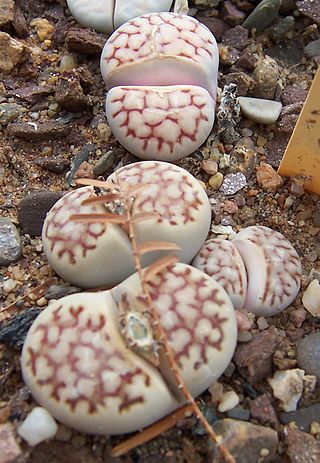
Lithops karasmontana, is a species of flowering plant in the ice plant family Aizoaceae, native to Namibia and South Africa.
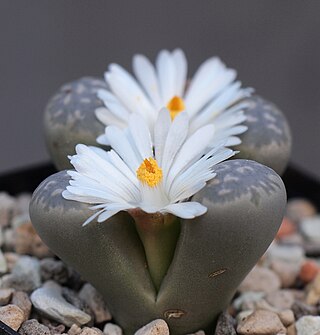
Lithops marmorata is a species of succulent pebble plant. It is native to Southern Africa. The specific name is derived from the Latin word marmorata meaning "marbled".

Lithops olivacea is a species of the genus Lithops under the family Aizoaceae. The name olivacea refers to the Latin word for olive (oliva) combined with the suffix -cea, meaning "of the likeness", producing the idea of "olive likeness". Lithops olivacea grow primarily in the Bushmandland of South Africa. They grow most abundantly in the regions of Aggeneys, Pofadder, and Namies. L. olivacea also received the Royal Horticultural Society's Award of Garden Merit for being "excellent for ordinary use in appropriate conditions, available to buy, of good constitution, essentially stable in form & colour, [and] reasonably resistant to pests & diseases."
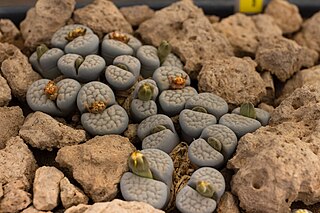
Lithops schwantesii is a succulent plant of the genus Lithops and a member of the family Aizoaceae. L. schwantesii receives its name from Gustav Schwantes, a prominent archaeologist and botanist of late 19th and 20th century. The succulent also received the Royal Horticultural Society's Award of Garden Merit for being a resilient and easy to cultivate plant.
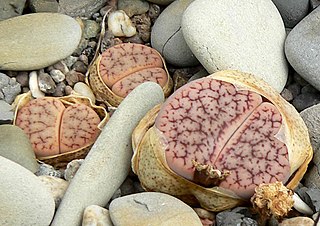
Lithops pseudotruncatella is a species of succulent in the family Aizoaceae. Initial confusion associated with Conophytum truncatum is where it derives its name, literally meaning "fake-truncatum". It also received The Royal Horticultural Society's Award of Garden Merit. The plant is endemic to Namibia.
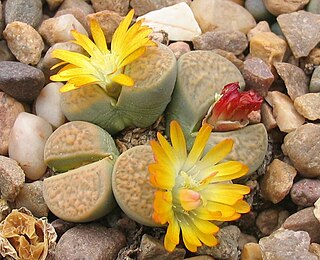
Lithops divergens is a succulent plant species in the genus Lithops of the family Aizoaceae. It is endemic to the western Cape Provinces of South Africa. It is able to withstand intense climatic changes due to its resilience as a succulent. The average annual rainfall for its natural environment is less than 150 mm, occurring primarily in winter which is unusual for a Lithops.
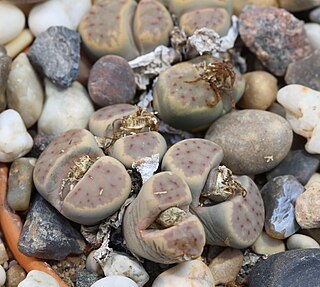
Lithops dinteri is a species of the genus Lithops of the family Aizoaceae. It is a succulent plant native to the desert climate of Southern Africa, where is receives an average yearly rainfall of 464 mm. The succulent plant is named after Mortiz Kurt Dinter, a German botanist of the late 19th and early 20th century. He was a collector of exotic succulents and his collection numbered around 8,400 pressed specimens.
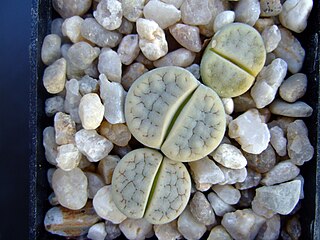
Lithops gracilidelineata is a species of the genus Lithops under the family Aizoaceae. The succulent plant lives in the southern region of Africa, and receives its name from the Latin words gracili and linea, combining to form the translation of "fine lined".

Lithops otzeniana is a species of succulent plant under the genus Lithops. It belongs to the family Aizoaceae. L. otzeniana is native to to the Northern Cape province of South Africa. It derives its name from M. Otzen, who invited its discoverer, G.C. Nel, on the trip in which he discovered it.
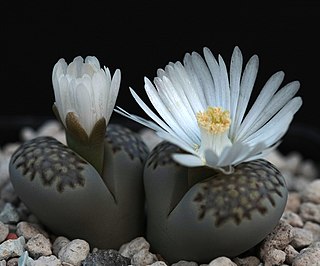
Lithops julii is a species of succulent plant of the genus Lithops under the family Aizoaceae. It is native to Southern Africa, and was first collected by Kurt Dinter, a German botanist, and named after his friend, Julius Derenberg.
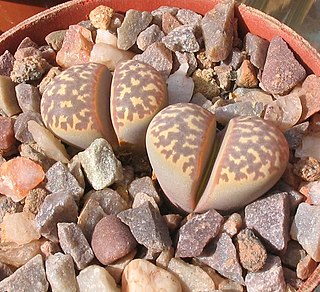
Lithops naureeniae is a species of pebble plant (Lithops), in the family Aizoaceae. It is native to the Northern Cape province of South Africa. The succulent is adapted to the desert climate in which it lives. L. naureeniae was identified in 1980 by Desmond Cole, who became involved in Lithops research in 1947, from a specimen provided to him by Bruce Bayer, curator of the Karoo Botanic Garden, having been collected by Peter V. Bruyns in Namaqualand. It is named after Cole's wife, Naureen Cole. Cole wrote:
I therefore have pleasure in dedicating it to the person who, during the last fifteen years, directly and indirectly, has contributed more to research on and knowledge of the genus Lithops than any other—my wife, Naureen

Lithops meyeri is a species of living stone (Lithops), under the family Aizoaceae. It is native to the Northern Cape province of South Africa. It is named after Rev. Gottlieb Meyer.
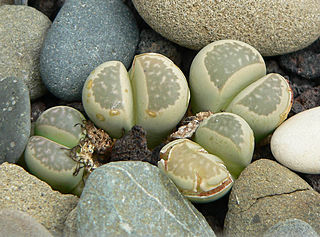
Lithops herrei is a species of succulent plant under the genus Lithops and family Aizoaceae. It derives its name from Adolar Herre, a German botanist of the 20th century.
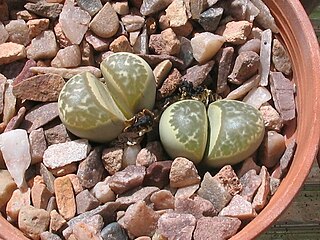
Lithops helmutii is a species of pebble plant. It is native to the northwestern Cape Provinces of South Africa.
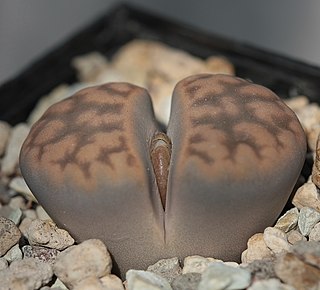
Lithops hallii is a species of living stone (Lithops). It is native to the northern Cape Provinces of South Africa. It is a species of the genus Lithops under the family Aizoaceae.

Lithops geyeri is a species of pebble plant. It is native to South Africa.
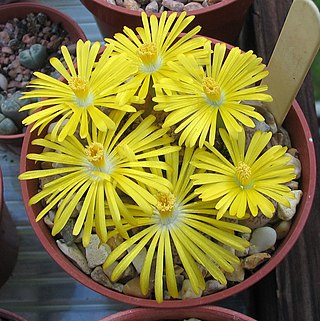
Lithops gesineae is a species of the genus Lithops under the family Aizoaceae. It is native to Namibia.

Rumex bucephalophorus, also known as horned, red, or ruby dock is an annual herbaceous plant that is part of the family Polygonaceae. The scientific name Rumex bucephalophorus was first described and published by Linnaeus in 1753 in Species Plantarum. Other scientific names have also been given to Rumex bucephalophorus such as Bucephalophora aculeata and Lapathum bucephalophorum. R. bucephalophorus is most commonly found in subcoastal or coastal regions, but also are "casual aliens", few and far between, among inland populations. Rumex bucephalophorus is native to the Mediterranean Basin and grows best in areas with little human intervention.




















